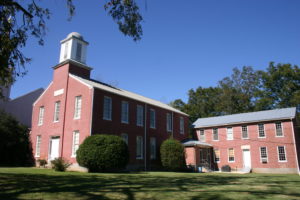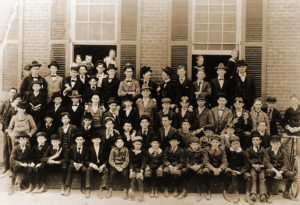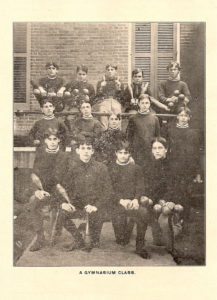 After settling its outstanding debts, the church got cash and real estate amounting to close to $40,000. They didn’t want to start another college, in part because they didn’t know if they could successfully compete with the University of Mississippi, which had been founded in 1848. But they were still interested in Christian education. So, the Mississippi Presbyterians decided to use the money to start an Academy to prepare boys for college, and thus for life as both churchmen and ministers. They also wanted the Academy to be founded close to the location of Oakland College in order to honor the original donors’ wishes to provide quality education in Southwest Mississippi.
After settling its outstanding debts, the church got cash and real estate amounting to close to $40,000. They didn’t want to start another college, in part because they didn’t know if they could successfully compete with the University of Mississippi, which had been founded in 1848. But they were still interested in Christian education. So, the Mississippi Presbyterians decided to use the money to start an Academy to prepare boys for college, and thus for life as both churchmen and ministers. They also wanted the Academy to be founded close to the location of Oakland College in order to honor the original donors’ wishes to provide quality education in Southwest Mississippi.
 The Presbytery chose Port Gibson as the site of the new Academy, primarily because there were some fine brick school buildings located right behind the Presbyterian Church which could house the school. That meant the Presbytery could use their money to endow the school rather than to build buildings. Because the new Academy was in a very real sense a successor to Oakland College, the Presbytery decided to name it Chamberlain-Hunt Academy after Jeremiah Chamberlain, the first President of Oakland College.
The Presbytery chose Port Gibson as the site of the new Academy, primarily because there were some fine brick school buildings located right behind the Presbyterian Church which could house the school. That meant the Presbytery could use their money to endow the school rather than to build buildings. Because the new Academy was in a very real sense a successor to Oakland College, the Presbytery decided to name it Chamberlain-Hunt Academy after Jeremiah Chamberlain, the first President of Oakland College.
The other man for whom the Academy is named, David Hunt, was also connected with Oakland College. He was a very generous donor, giving over the course of his life $175,000 to the College – a gift with a modern value of around $20 million. No wonder a grateful church decided to name its new Academy in his honor.
 Oakland College closed in 1871, but the new Academy didn’t start up until the Fall of 1879. That’s because a new board of trustees had to be elected, the funds had to be transferred to the board, and faculty had to be recruited. To make matters worse, all during this time the entire state was suffering through the terrible post-war economic depression. And just when the Academy was ready to open in the Fall of 1878, a terrible yellow-fever epidemic struck the area. The first President of the Board of Trustees, Rev. Samuel Reading Bertron, died of the fever. The fact that the Academy still managed to begin operations in the Fall of 1879 is therefore a testimony to the grace of God and to the perseverance of Mississippi’s Presbyterians.
Oakland College closed in 1871, but the new Academy didn’t start up until the Fall of 1879. That’s because a new board of trustees had to be elected, the funds had to be transferred to the board, and faculty had to be recruited. To make matters worse, all during this time the entire state was suffering through the terrible post-war economic depression. And just when the Academy was ready to open in the Fall of 1878, a terrible yellow-fever epidemic struck the area. The first President of the Board of Trustees, Rev. Samuel Reading Bertron, died of the fever. The fact that the Academy still managed to begin operations in the Fall of 1879 is therefore a testimony to the grace of God and to the perseverance of Mississippi’s Presbyterians.
 The Academy featured a typical college preparatory curriculum of the day, heavy on Ancient and modern languages, but also including natural sciences and English literature. A gymnasium for gymnastics provided exercise for the boys. But by the 1890’s, more modern forms of exercise became popular, and both a baseball and a football team had been organized at the Academy. Milling M. Satterfield had graduated from Chamberlain-Hunt in 1889, and then studied law at Ole Miss. He returned to the Academy to teach and to become the Academy’s first football coach in the Fall of 1894.
The Academy featured a typical college preparatory curriculum of the day, heavy on Ancient and modern languages, but also including natural sciences and English literature. A gymnasium for gymnastics provided exercise for the boys. But by the 1890’s, more modern forms of exercise became popular, and both a baseball and a football team had been organized at the Academy. Milling M. Satterfield had graduated from Chamberlain-Hunt in 1889, and then studied law at Ole Miss. He returned to the Academy to teach and to become the Academy’s first football coach in the Fall of 1894.
 Milling Satterfield was also responsible for starting the military program at the Academy. He was the first commandant of Cadets in 1895. At first the military program was optional, but by the end of Principal Guthrie’s time at CHA, it was mandatory.
Milling Satterfield was also responsible for starting the military program at the Academy. He was the first commandant of Cadets in 1895. At first the military program was optional, but by the end of Principal Guthrie’s time at CHA, it was mandatory.
The connection between the Academy and the Presbyterian Church was very strong in these years. The pastor of the local Presbyterian Church, David Planck, taught on the faculty – most often courses in the Bible. The school also opened and closed each day with prayer, and students were expected to worship with the President in the Presbyterian Church, or with one of the members of the faculty who belonged to one of the other churches in town. A very active YMCA served the spiritual needs of the students. The first two Principals of the Academy, Mr. John Leckey and Mr. Walter Craig Guthrie, were both elders in the Presbyterian Church. And of course since the Presbytery and later the Synod owned and operated the Academy, the Trustees were approved by the Church as well.
Walter C. Guthrie was the second principal of the Academy, and he served from 1882 all the way until 1907. Like Mr. Leckey, he was a graduate of Washington and Lee University in Virginia. He was a firm believer in the benefits of a “well-conducted boarding school,” so it is appropriate that the oldest dormitory on the new campus would be named after him.